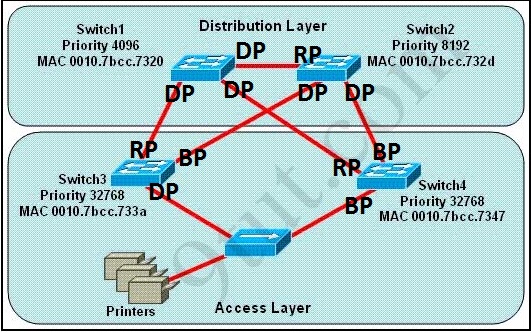STP Questions 2
Note: If you are not sure about Spanning Tree Protocol, please read our Spanning Tree Protocol STP Tutorial.
Question 1
Explanation
When you enable PortFast on the switch, spanning tree places ports in the forwarding state immediately, instead of going through the listening, learning, and forwarding states.
Question 2
Question 3
Explanation
Root port is the port on non-root bridge which is closest to the root bridge (in term of cost). Therefore when a port receives the best BPDU on a non-root bridge it will become the root port.
Question 4
Explanation
We can configure the port priority to change the preferred forwarding interface as we wish. For example we can change the port priority of an interface for VLAN 20 to 64 as follows:
Switch(config-if)#spanning-tree vlan 20 port-priority 64
Question 5
Explanation
Per VLAN Spanning Tree (PVST) maintains a spanning tree instance for each VLAN configured in the network. It means a switch can be the root bridge of a VLAN while another switch can be the root bridge of other VLANs in a common topology. For example, Switch 1 can be the root bridge for Voice data while Switch 2 can be the root bridge for Video data. If designed correctly, it can optimize the network traffic.
Question 6
Question 7
Question 8
Explanation
PortFast BPDU guard prevents loops by moving a nontrunking port into an errdisable state when a BPDU is received on that port.
In a valid configuration, PortFast-configured interfaces do not receive BPDUs (because PortFast should only be configured on interfaces which are connected to hosts). If a PortFast-configured interface receives a BPDU, an invalid configuration exists. BPDU guard provides a secure response to invalid configurations because the administrator must manually put the interface back in service.
Question 9
Question 10
Explanation
First, the question asks what switch services the printers, so it can be Switch 3 or Switch 4 which is connected directly to the Printers.
Next, by comparing the MAC address of Switch 3 and Switch 4 we found that the MAC of Switch 3 is smaller. Therefore the interface connected to the Printers of Switch 3 will become designated interface and the interface of Switch 4 will be blocked. The picture below shows the roles of all ports:

DP: Designated Port
RP: Root Port
BP: Blocked Port
(Please notice that Switch 1 will become the root bridge because of its lowest priority, not Switch 3)



Question 2
Which switch would STP choose to become the root bridge in the selection process?
A. 32768: 11-22-33-44-55-66
B. 32768: 22-33-44-55-66-77
C. 32769: 11-22-33-44-55-65
D. 32769: 22-33-44-55-66-78
Answer: A ..?
Should the answer not be ‘C’ as it has a LOWEST priority?? 65 is Lower than 66…